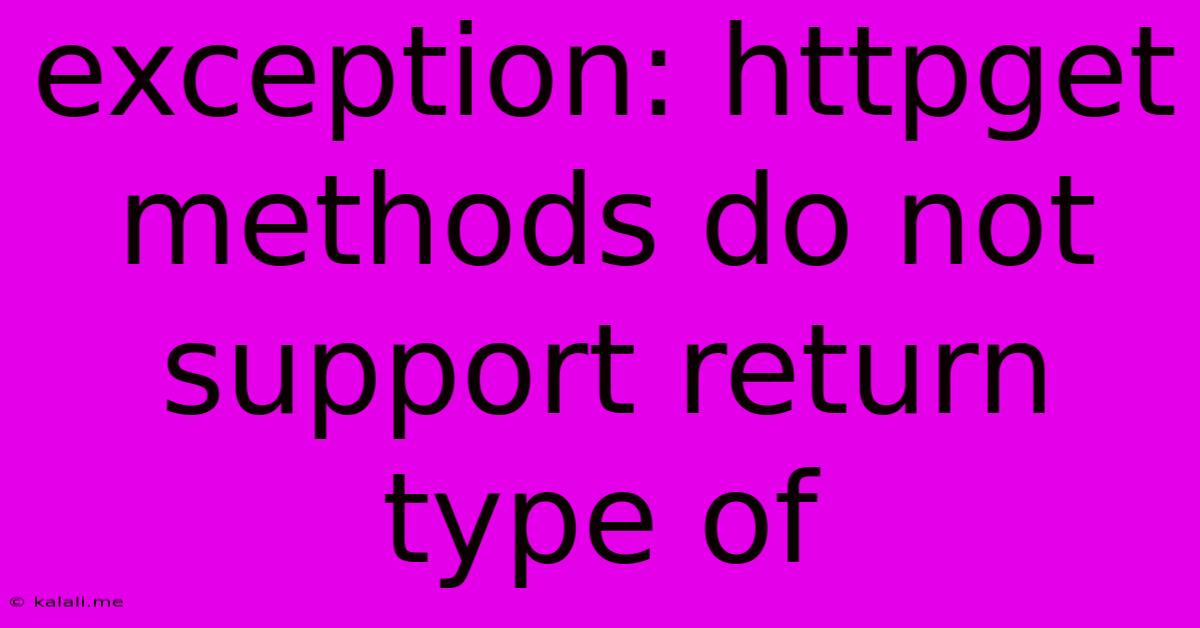Exception: Httpget Methods Do Not Support Return Type Of
Kalali
May 24, 2025 · 4 min read

Table of Contents
Exception: HTTP GET Methods Do Not Support Return Type of…
This error, "Exception: HTTP GET methods do not support return type of...", typically arises when attempting to use an HTTP GET request to retrieve data that requires a specific return type beyond a simple response body. This article will explore the root cause of this exception, explain why GET requests are limited in this way, and provide solutions to overcome this limitation. Understanding this error is crucial for building robust and efficient RESTful APIs.
Understanding HTTP Methods and Their Purpose
HTTP (Hypertext Transfer Protocol) defines a set of methods, or verbs, to interact with web servers. The most common are GET, POST, PUT, DELETE, and PATCH. Each method has a specific purpose:
-
GET: Retrieves data from a specified resource. It's designed for retrieving information and should be idempotent (meaning multiple calls have the same effect as a single call). Crucially, GET requests are generally expected to return a simple response body, often in formats like JSON or XML.
-
POST: Submits data to be processed to the specified resource. This is commonly used for creating new resources or triggering actions on the server.
-
PUT: Replaces all current representations of the target resource with the request payload.
-
DELETE: Deletes the specified resource.
-
PATCH: Applies partial modifications to a resource.
Why GET Requests Have Limited Return Types
The core reason behind the "Exception: HTTP GET methods do not support return type of..." error is the inherent design of the HTTP GET method. GET requests are intended to retrieve data; they are not designed to handle complex return types or operations that modify server-side state. Attempting to enforce a specific return type beyond the standard response body (e.g., forcing a return of a specific object or class) violates this principle. The expectation is a simple data retrieval; any complex processing or object instantiation should be handled on the client-side after receiving the response.
Troubleshooting and Solutions
If you encounter this exception, it's likely you're trying to use a GET request inappropriately. The solution involves re-evaluating your API design and choosing the correct HTTP method. Here are common scenarios and solutions:
-
Scenario: You need to retrieve complex data requiring object instantiation on the server.
- Solution: Use a POST request instead. POST requests are ideal for scenarios where you need the server to perform more complex operations and return a custom object. The server can process the request, create the object, and return it as a JSON or XML representation.
-
Scenario: You're trying to force a specific return type in your API endpoint definition.
- Solution: Review your endpoint definition and ensure you're not trying to force a return type that isn't compatible with a standard GET response. The server should simply return the data; the client-side code should handle the deserialization and object creation.
-
Scenario: You're using a framework or library with strict type checking.
- Solution: Configure your framework or library to handle the GET request's response appropriately, allowing for flexibility in data handling on the client side. This often involves adjusting type declarations or using more generic data structures.
-
Scenario: The API design is flawed.
- Solution: Refactor your API design. Consider if GET is the correct method for your intended operation. If the operation involves creating, updating, or deleting data, using POST, PUT, PATCH, or DELETE would be more appropriate.
Best Practices for API Design
To avoid this error in the future, follow these best practices:
-
Choose the right HTTP method: Use GET for retrieving data, POST for creating, PUT for updating, DELETE for deleting, and PATCH for partial updates.
-
Keep GET requests simple: Design GET endpoints to return simple data structures. Avoid complex processing or object creation on the server-side.
-
Use appropriate data formats: Return data in commonly used formats such as JSON or XML for easy parsing on the client-side.
-
Document your APIs thoroughly: Clear and comprehensive documentation helps prevent misunderstandings and errors in API usage.
By understanding the limitations of HTTP GET requests and following these best practices, you can build robust and efficient RESTful APIs that are free from this common exception. Remember, proper API design is essential for creating scalable and maintainable applications.
Latest Posts
Latest Posts
-
Mother And I Or Mother And Me
Jul 18, 2025
-
How Many Oz In One Water Bottle
Jul 18, 2025
-
How Many Dimes In A 5 Roll
Jul 18, 2025
-
How Do You Say Basil In Spanish
Jul 18, 2025
-
How Many Cookies Are In A Dozen
Jul 18, 2025
Related Post
Thank you for visiting our website which covers about Exception: Httpget Methods Do Not Support Return Type Of . We hope the information provided has been useful to you. Feel free to contact us if you have any questions or need further assistance. See you next time and don't miss to bookmark.